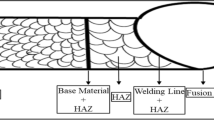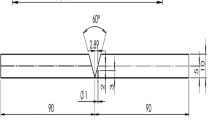Abstract
In this study, the weldability of high-hardness armor steel by the gas metal arc welding method has been investigated. The study was aimed at determining the weakness points of manual welding compared to automated welding through microhardness testing, the cooling rate, tensile characteristics and nondestructive analysis. Detailed studies were performed for automated welding on the impact energy and microhardness in the fusion line, as the most sensitive zone of the armor steel weld joint. It was demonstrated that the selection of the preheating and interpass temperature is important in terms of the cooling rate and quantity of diffusible and retained hydrogen in the weld joint. The tensile strength was higher than 800 MPa. The width of the heat-affected zone did not exceed 15.9 mm, measured from the weld centerline, while the impact energy results were 74 and 39 J at 20 and – 40 °C, respectively.


















Similar content being viewed by others
References
R.G. Madhusudhan and T. Mohandas, Ballistic Performance of High-Strength Low Alloy Steel Weldments, J. Mater. Process. Technol., 1996, 57, p 23–30
Kuzmikova, L., 2013. An investigation of the weldability of high hardness armour steel. Doctor of Philosophy thesis. Faculty of engineering, University of Wollongong, Australia.
MIL-STD-1185, Department of defense manufacturing process standard: welding, high hardness armor; [SUPERSEDES MIL-W-62162] (2008)
K. Namkug, H. Sol, and R. Myung-Il, Design of Controller for Mobile Robot in Welding Process of Shipbuilding Engineering, J. Comput. Des. Eng., 2014, 1(4), p 243–255
G. Magudeeswaran, V. Balasubramanian, G.R. Madhushudan, and T. Balasubramanian, Effect of Welding Processes and Consumable on Tensile and Impact properties of High Strength Quenched and Tempered Steel Joints, J. Iron. Steel Res. Int., 2008, 15(6), p 97–97
S.J. Alkemade, The weld cracking susceptibility of high hardness armour steel, Defence Science and Technology Organisation. 24. 1996
E.W. Rentzel et al., Hybrid Laser-GMA Welding for Improved Affordability, J. Ship Prod., 2008, 24(2), p 72–81
M. Atabaki, M.J. Mazar, G. Yang, and R. Kovacevic, Hybrid Laser/Arc Welding of Advanced High Strength Steel in Different Butt Joint Configuration, Mater. Des., 2014, 64, p 573–587
ESAB 2014. Advantages and Disadvantages of Metal Cored Wires. [Cited 2014 26.3.2014], http://www.esabna.com/us/en/education/blog/advantages-and-disadvantages-of-metal-cored-wires.cfm
L. Kuzmikova, H. Li, J. Norrish, Z.Stephen Pan, and N. Larkin, Development of Safe Optimized Welding Procedures for High Strength Q&T Steel Welded with Austenitic Consumables, Revista Soldagem e Inspecao, 2013, 18(2), p 169–175
E.O. Hall, The Deformation and Ageing of Mild Steel: III, Discussion of Results, Proc. Phys. Soc. B, 1951, 64, p 747–753
N.J. Petch, The Cleavage Strengh of Polycrystals, J. Iron Steel Inst., 1953, 174, p 25–28
EN ISO 5817:2014. Welding. Fusion-Welded Joints in Steel, Nickel, Titanium and Their Alloys (Beam Welding Excluded). Quality Levels for Imperfections.
EN ISO 3690:2012. Welding and Allied Processes. Determination of Hydrogen Content in Arc Weld Metal.
EN ISO 9015-1:2011. Destructive Tests on Welds in Metallic Materials. Hardness Testing Hardness Test on Arc Welded Joints.
EN ISO 4136:2011. Destructive Tests on Welds in Metallic Materials. Transverse Tensile Test.
EN ISO 643:2012. Micrographic Determination of the Apparent Grain Size.
ASTM E2298-15, Standard Test Method for Instrumented Impact Testing of Metallic Materials, ASTM International, West Conshohocken, PA, 2015
P. Kamal, B. Sandip, and P.K. Surjya, Investigation on Arc Sound and Metal Transfer Modes for On-line Monitoring in Pulsed Gas Metal Arc Welding, J. Mater. Process. Technol., 2010, 210, p 1397–1410
J. Bernetič, Development of model for predicting hardenability of high strength low alloy steels, Ph. D. Thesis, Ljubljana, 2013
T. Yuan, Z. Luo, and S. Kou, Grain Refining of Magnesium Welds by Arc Oscillation, Acta Mater., 2016, 116, p 166–176
R.G.D. Janaki, R. Murugesan, and S. Sundaresan, Fusion Zone Grain Refinement in Aluminum Alloy Welds Through Magnetic Arc Oscillation and Its Effect on Tensile Behavior, J. Mater. Eng. Perform., 1999, 8, p 513–520
G. Magudeeswaran, V. Balasubramanian, S. Sathyanarayanan, and G.R. Madhusudhan, Dynamic Fracture Toughness of Armour Grade Quenched and Tempered Steel Joints Fabricated Using Low Hydrogen Ferritic Fillers, J. Iron. Steel Res. Int., 2010, 17(5), p 51–56
R. Madhusudhan, T. Mohandas, and K. Papukutty, Effect of Welding Process on the Ballistic Performance of High Strength Low-Alloy Steel Weldments, J. Mater. Process. Technol., 1998, 74(1–3), p 27–35
A.F. Padilha, C.F. Tavares, and M.A. Martorano, Delta Ferrite Formation in Austenitic Stainless Steel Castings, Mater. Sci. Forum, 2013, 730–732, p 733–738
P. L axminarayana, R.A Chennakesava, Quantification of Delta Ferrite in Austenitic Stainless Steel Cast in Investments Shell Moulds, in 4th National Conference on Materials and Manufacturing Processes Hyderabad, Andhra Pradesh, India (2008)
L. Kuzmikova, J. Norrish, H. Li, M. Callaghan, Research to establish a systematic approach to safe welding procedure development using austenitic filler material for fabrication of high strength steel, in 16th International Conference on the Joining of Materials, 2011, pp. 1–13
G. Magudeeswaran and V.R. Balasubramanian, Effect of Welding Processes and Consumables on Fatigue Crack Growth Behaviour of Armour Grade Quenched and Tempered Steel Joints, Def. Technol., 2014, 10, p 47–59
V.S.R. Murti, P.D. Srinivas, G.H.D. Banadeki, and K.S. Raju, Effect of Heat Input on the Metallurgical Properties of HSLA Steel in Multi-pass MIG Welding, J. Mater. Process. Technol., 1993, 37, p 759–765
S. Babu, V. Balasubramanian, G.R. Madhusudhan, and T.S. Balasubramanian, Improving the Ballistic Immunity of Armour Steel Weldments by Plasma Transferred Arc (PTA) Hardfacing, Mater. Des., 2010, 31, p 2664–2669
G. Magudeeswaran, V. Balasubramanian, and G.R. Madhusudhan, Effect of Welding Processes and Consumables on High Cycle Fatigue Life of High Strength, Quenched and Tempered Joints, Mater. Des., 2008, 29, p 1821–1827
B. Bialobrzeska, L. Konat, and R. Jasinski, The Influence of Austenite Grain Size on the Mechanical Properties of Low-Alloy Steel with Boron, Metals, 2017, 7, p 26. https://doi.org/10.3390/met7010026
Manufacturer’s Data. http://www.niobelcon.com/NiobelCon/niobium/niobium_in_automotive_flat_steel/auto_martensitic_steel/tough_martensite/
Acknowledgments
The authors would like to thank Dr. Zijah Burzic and the Military Technical Institute for mechanical testing. This study was financially supported by the Ministry of Education, Science and Technological Development of the Republic of Serbia through Project No. ON 174004.
Author information
Authors and Affiliations
Corresponding author
Rights and permissions
About this article
Cite this article
Cabrilo, A., Geric, K., Jovanovic, M. et al. Weldability and Impact Energy Properties of High-Hardness Armor Steel. J. of Materi Eng and Perform 27, 1281–1295 (2018). https://doi.org/10.1007/s11665-018-3211-3
Received:
Revised:
Published:
Issue Date:
DOI: https://doi.org/10.1007/s11665-018-3211-3




